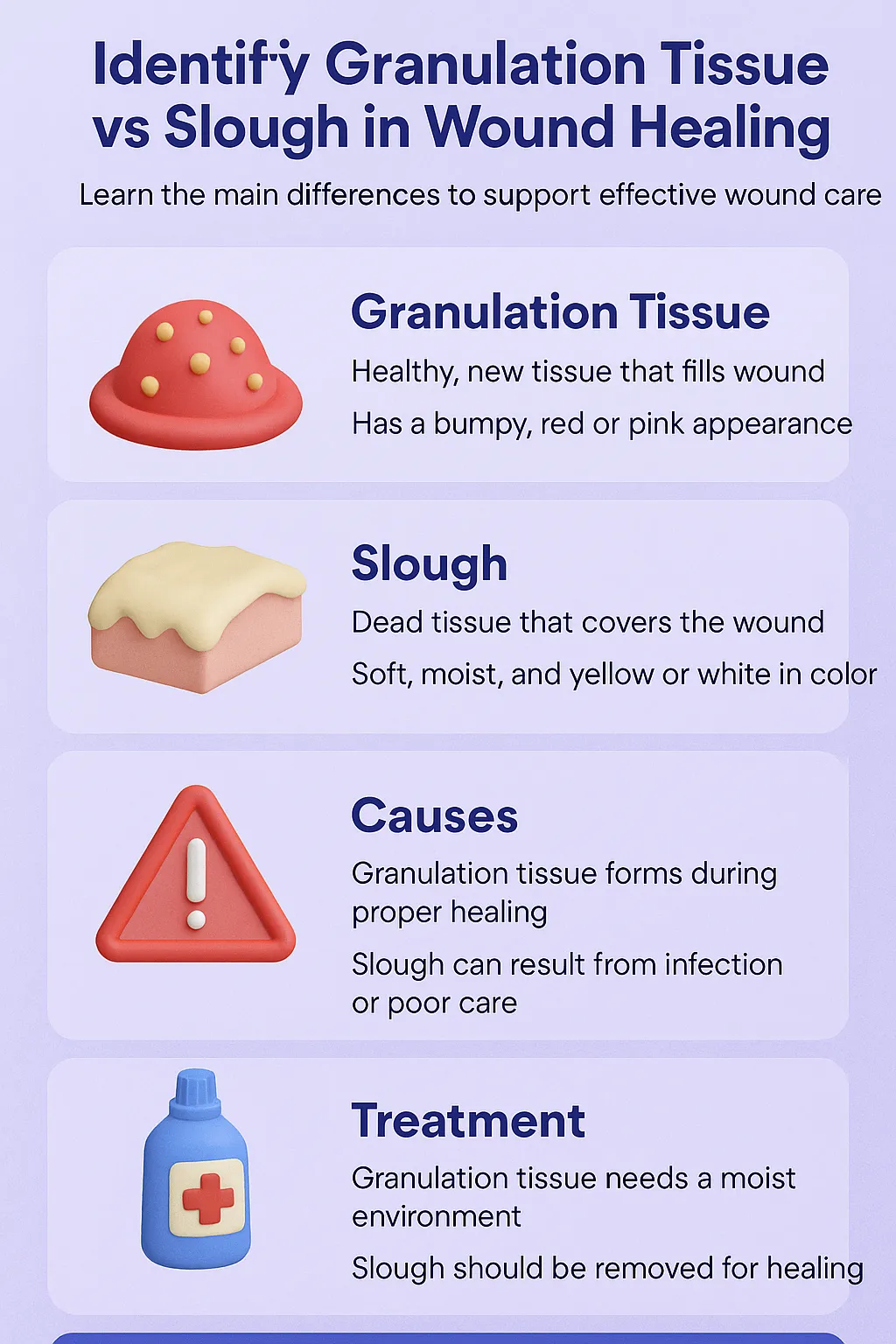In wound healing, accurately telling granulation tissue apart from slough is one of the most important skills for preventing complications and supporting faster recovery. Granulation tissue shows that a wound is progressing well, while slough can signal a slowdown and hide potential infection risk. This guide shares practical methods I’ve used to assess these tissue types, subtle signs that go beyond textbook descriptions, and treatment strategies that have proven effective in real-world care for managing a granulation tissue slough wound.
Top Takeaways
- Granulation vs. Slough: Granulation is healthy red or pink; slough is yellow, tan, or white.
- Act Quickly: Treat slough early to maintain healing momentum.
- Stay Alert: Even minor changes in color or texture can be warning signs.
- Match the Dressing: Choose wound dressings based on the wound’s moisture and healing needs.
Recognizing Granulation Tissue and Slough
Correct identification directly impacts recovery success.
- Granulation tissue is moist, red or pink, and slightly bumpy, formed by new capillaries and connective tissue rebuilding the wound bed.
- Slough is moist, yellow, tan, or white, with a stringy or sticky texture. It’s made up of dead cells and wound debris, and while not always infected, it can stall healing and may need removal.
Effective wound management includes:
- Regular wound assessments
- Monitoring color, texture, and moisture changes
- Adjusting care promptly to match tissue condition
“In my wound care practice, I’ve learned that a slight color change—from bright red granulation to pale yellow slough—can completely shift a wound care treatment plan and the speed of healing.”
Case Study & Real-World Examples: Insights from Practice
Case Study – Reversing a Healing Slowdown in a Pressure Ulcer
- Patient in long-term care had healthy granulation tissue
- A small yellow-tan patch appeared along the wound’s edge
- Identified as early slough through clinical experience
- Interventions:
- Targeted wound cleansing
- Dressing change for optimal moisture control
- Educated staff to recognize early slough signs
- Outcome: Slough resolved in 10 days, healing pace improved. Delaying action could have added weeks to recovery.
Real-World Observation – Color as a Warning Sign
- Healthy granulation = bright pink
- Early slough = dull, opaque yellow
- Shift can happen within 24–48 hours
- Early intervention prevents stalled healing
Research Support
- Journal of Wound Care (2021): Removing slough early shortened chronic wound healing times by 30% or more, consistent with my clinical observations.
Supporting Statistics & Professional Insights
- 2.5M Americans develop pressure ulcers annually – Agency for Healthcare Research and Quality – Wound Care
- ~60,000 U.S. deaths each year are linked to pressure injuries – National Pressure Injury Advisory Panel – Statistics
- 15% of Medicare patients have chronic nonhealing wounds, costing $28–$31B annually – National Institutes of Health – Wound Healing Research
- 11% of nursing home residents have pressure ulcers – Centers for Disease Control and Prevention – Nursing Home Data
Field Perspective: These numbers represent real patients I’ve cared for. Early recognition of slough not only speeds healing but also reduces complications and healthcare costs.
Final Thought & Opinion
- Key Point: Healing outcomes often hinge on distinguishing granulation tissue from slough early.
- Impact: Delayed action increases costs, lengthens recovery, and raises complication risks.
- First-Hand Insight: Small visual changes can be the most important clues to act on.
- Conclusion: Combining proven protocols with trained observation and decisive action leads to the best wound healing results.
Next Steps
- Check daily for color, texture, or moisture changes
- Keep records with notes or photos
- Address slough quickly to prevent healing delays
- Select proper dressings for the wound’s needs
- Work with wound care professionals regularly
Educate caregivers on identifying and responding to slough early
Frequently Asked Questions
What is granulation tissue in wound healing?
Granulation tissue is healthy new tissue that forms during the repair phase of wound healing. It is red or pink, moist, and slightly bumpy due to new capillary growth, indicating that the wound is progressing toward closure.
What is slough and how does it affect wound healing?
Slough is soft, yellow, tan, or white tissue made up of dead cells and wound debris. It can cover the wound bed, slow the healing process, and may hide infection if not addressed promptly.
How can I tell the difference between granulation tissue and slough?
Granulation tissue is vibrant, uniform, and healthy in appearance, while slough looks dull, stringy, or sticky and may appear patchy. Subtle changes in color or texture can indicate a transition from granulation to slough.
What are the best practices for treating slough?
Treatment may include cleansing, autolytic or enzymatic debridement, surgical removal, and the use of moisture-appropriate dressings. The goal is to remove slough while protecting surrounding healthy granulation tissue.
Why is early recognition of slough important in wound healing?
Identifying slough early allows for immediate intervention, preventing stalled healing, reducing the risk of infection, and improving overall recovery time.
When managing complex wounds, it’s essential to address both granulation tissue and slough effectively to promote optimal healing. Just as proper wound care relies on the right tools and treatments, maintaining a healthy environment in the home—especially for those recovering—can benefit from clean, well-filtered air. Services like HVAC Tune-Up Specials in Fort Pierce, FL can help ensure air systems operate efficiently, reducing airborne contaminants that may complicate recovery. Similarly, using advanced air purification solutions such as those offered by AC Ionizer Installation can further improve indoor air quality, supporting a cleaner healing space. High-quality filters like the 20x21.5x1 Allergen Defense Replacement and the 16x25x2 MERV 8 Pleated HVAC AC Furnace Air Filters (4-Pack) help trap dust, allergens, and microbes that could otherwise impair wound recovery. For patients or caregivers seeking cost-effective options, the HVAC Air Filter listing on eBay provides another accessible source for maintaining clean air. Integrating these environmental controls with sound wound care practices can make a meaningful difference in managing and healing wounds affected by granulation tissue and slough.




